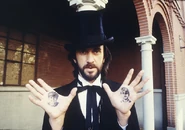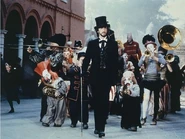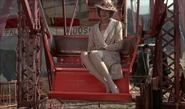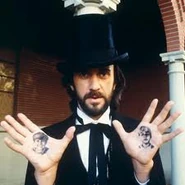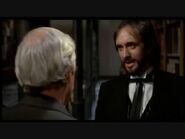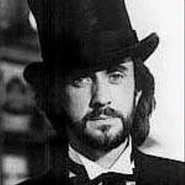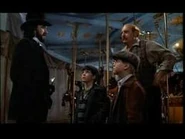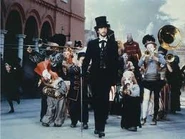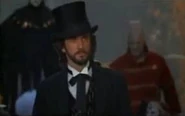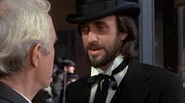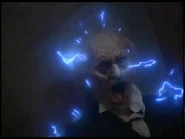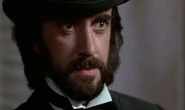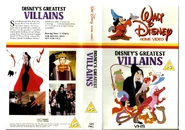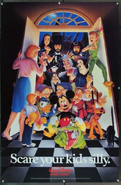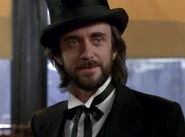Something Wicked This Way Comes is a 1983 American supernatural horror fantasy film directed by Jack Clayton and produced by Walt Disney Productions from a screenplay written by Ray Bradbury, based on his novel of the same name. The novel's title was taken directly from a line in Act IV of William Shakespeare's Macbeth: "By the pricking of my thumbs / Something wicked this way comes." The film stars Jason Robards, Jonathan Pryce, Diane Ladd, and Pam Grier. It was shot in Vermont and at the Walt Disney Studios in Burbank, California. The film had a troubled production – Clayton fell out with Bradbury over an uncredited script rewrite, and after test screenings of the director's cut failed to meet the studio's expectations, Disney sidelined Clayton, fired the original editor, and scrapped the original score, spending some $5 million and many months re-shooting, re-editing, and re-scoring the film, before its eventual release.
Synopsis[]
In Green Town, Illinois, a small town enjoying the innocence of an upcoming autumn as the days grow shorter, two young boys – reserved Will Halloway and somewhat rebellious Jim Nightshade – leave from an after-school detention for "whispering in class" and hurry off for home. When the boys hear about a strange traveling carnival, Mr. Dark's Pandemonium Carnival, from a lightning-rod salesman, they decide to see what it is all about, but Will is fearful, as most carnivals end their tours after Labor Day. When the ominous Mr. Dark, the Illustrated Man, rides into town on a dark midnight, setting up his massive carnival in a matter of seconds, the boys are both thrilled and terrified. It seems to be just another carnival at first, but it is not long before the forces of darkness begin to manifest from the haunting melodies of the carousel – which can change your age depending on which direction you ride it – and from the glaring Mirror Maze. With his collection of freaks and oddities, Dark intends to take control of the town and seize more innocent souls to damn. It will take all the wit and hope of the two boys to save their families and friends, with aid from an unlikely ally, Will's father, the town librarian, who understands more than anyone else that "something wicked this way comes."
Plot[]
In Green Town, Illinois, two young boys, a reserved Will Halloway, and somewhat rebellious Jim Nightshade, leave from an after-school detention for "whispering in class" and hurry off for home. The boys live next door to each other and were born a minute apart on Halloween. Will lives with his grey-haired father, Charles and mother, while Jim lives with his single mother; it is heavily implied that his father walked out on them. A lightning rod salesman named Tom Fury arrives and sells one to Jim, claiming that it will protect him from an upcoming storm. The boys soon hear of a carnival coming to town lead by the ominous Mr. Dark.
The carnival arrives and is set up overnight. Will and Jim notice that many of the residents seem oddly entranced by some of the attractions, such as the amputee bar tender, Ed, who sees his missing arm and leg return in a mirror and the boys' teacher, Miss Foley, who wishes to regain her youth. Will and Jim see a carousel that is closed off and are confronted by Mr. Dark who quickly becomes suspicious of them. Later, they witness Mr. Dark using the carousel on his assistant Mr. Cooger who reverts back to a little boy. Will and Jim head off to see Foley, but she is with her "nephew" who is actually Cooger and are forced to leave.
Foley suddenly becomes younger, but loses her vision and is taken by Cooger to Dark. Will gets into an argument with Jim when the latter reveals that he has always been envious of the former being older and wants to use the carousel. However, they witness Fury being tortured by Mr. Dark who wants the secret of the upcoming storm and uses his other assistant the Dust Witch to seduce him, but to no avail. The boys run when they are found out and try to go to bed. In the middle of the night, the two are attacked by spiders, but the lightning rod that Fury gave Jim earlier saves them.
In the morning, Mr. Dark leads his carnival, now consisting of some of the townspeople, in a parade, though Will and Jim deduce that it is a search party for them. Charles eventually figures out that the boys are in trouble and when confronted by Mr. Dark manages to deter him. Charles, Will, and Jim head to the library, where the former reveals that the carnival had come to town before and that his own father had fought them. Mr. Dark arrives searching for Will and Jim and offers Charles his youth back, but he resists. He knocks out Charles and makes off with the boys back to the carnival. Charles regains himself and heads to the carnival just as the storm arrives. He runs into Jim's mother and deters her before she too succumbs to Mr. Dark's powers.
Charles heads into the hall of mirrors where Mr. Dark continues to haunt him about his age. However, Will declares his love for his father and repel the Dust Witch, allowing Fury to escape his imprisonment and impale her with a lightning rod. Will and Charles find Mr. Dark attempting to use the carousel with Jim in tow, but they rescue him just as lightning strikes the ride. As Mr. Dark begins to age and decay, Will and Charles express happiness to awaken Jim and the three flee just as the carnival begins to get sucked away into a giant twister. Will, Jim, and Charles head back into town and begin to happily dance back home, with the danger now over.
Cast[]
- Jason Robards as Charles Halloway
- Jonathan Pryce as Mr. Dark
- Diane Ladd as Mrs. Nightshade
- Royal Dano as Tom Fury
- Vidal Peterson as Will Halloway
- Arthur Hill as Adult Will (Narrator)
- Shawn Carson as Jim Nightshade
- Mary Grace Canfield as Miss Foley
- Sharan Lea as Young Miss Foley
- Richard Davalos as Mr. Crosetti
- Jack Dodson as Dr. Douglas
- Bruce M. Fischer as Mr. Cooger
- Pam Grier as the Dust Witch
- Jack Dengel as Mr. Tetley
- Ellen Geer as Mrs. Halloway
- James Stacy as Ed, the Bartender
- Tony Christopher as Young Ed
- Angelo Rossitto as Little Person #1
- Phil Fondacaro as Demon Clown
Production[]
Ray Bradbury wrote the screenplay in 1958, intended as a directorial vehicle for Gene Kelly. Financing for the project never came, and Bradbury converted the screenplay into a novel, published in 1962.[1]
In 1977, Bradbury sold the film rights to Something Wicked This Way Comes to Paramount Pictures. He and director Jack Clayton, who Bradbury had previously worked with on Moby Dick, produced a completed script. The movie was intended to be produced by Kirk Douglas' Bryna Productions, and Douglas was to have starred in it. However, production never began and the film was eventually put into turnaround. At various times, Sam Peckinpah and Steven Spielberg expressed interest in making the film.[1]
At this time Walt Disney Productions was concentrating on films with more mature themes in an attempt to break free from their stereotype as an animation and family film studio on April 1, 1983. After the success of family-oriented fantasy pictures by competing studios, such as Time Bandits and The Dark Crystal, Disney decided to purchase the adaptation's rights and hired Bradbury to produce a new script from scratch.[2]
The studio sought Bradbury's input on selecting a cast and director, and he suggested Clayton feeling they had worked well together at Paramount. In a 1981 issue of Cinefantastique, Bradbury stated that his top choices to play Mr. Dark were Peter O'Toole and Christopher Lee. However, Disney decided to go with a relatively unknown actor instead in order to keep the budget down, and Jonathan Pryce was eventually cast. As the film progressed, two differing visions emerged for the film, with Bradbury and Clayton wishing to stay as faithful to the novel as possible, while Disney wanted to make a more accessible and family friendly film. Bradbury and Clayton fell out during production after Bradbury discovered that Clayton had hired writer John Mortimer to do an uncredited revision of Bradbury's screenplay at the studio's insistence.[3]
At a Q&A session following a 2012 screening of the film, actor Shawn Carson explained that he originally read some 10 times for the part of Will, but after a request from Bradbury, he read for and was cast in the part of Jim Nightshade instead. Although he had blond hair at the time, and co-star Vidal Petersen had dark hair, Carson's hair was dyed jet black and Petersen's was dyed blond to fit the new casting.
For the original score, Clayton picked Georges Delerue who had scored his films: The Pumpkin Eater and Our Mother's House, but his score (considered "too dark" by Disney) was later removed and replaced at short notice with a score by James Horner. A soundtrack album of Delerue's unused score was released by Intrada Records in 2015.[4]
Editor Barry Gordon was hired as assistant to the film's original editor, Argyle Nelson Jr. He recalled in 2012 that after Clayton submitted his original cut, Disney expressed concerns about the film's length, pacing, and commercial appeal; the studio then took the project out of Clayton's hands and undertook an expensive six-month reshoot and re-edit. Nelson was let go for budgetary reasons, and although Gordon was originally prepared to follow Nelson and leave the production, Nelson encouraged him to stay, and Gordon edited the final cut (resulting in the film's dual editor credits).
Disney spent an additional $5 million on re-filming, re-editing, and re-scoring the picture, and Gordon was required to make a number of changes to Clayton and Nelson's original cut, removing several major special-effects scenes, and incorporating the new material (directed by Leo Dyer), including a new spoken prologue, narrated by Arthur Hill. Among the casualties was a groundbreaking animation scene, which would have been one of the first major uses of computer-generated imaging in a Hollywood film; combining the then new technology of CGI with traditional animation, it depicted Dark's circus train rolling into town, and the carnival magically materializing – the smoke from the locomotive becomes the ropes and tents, tree limbs grow together to form a ferris wheel, and a spider web morphs into a wheel of fortune. The deleted scene was previewed in detail in the May–June 1983 issue of Twilight Zone Magazine, but in the event, the re-edit retained only a few seconds of the sequence. Another cut sequence depicted Mr. Dark using his sinister powers to send a huge disembodied hand to reach into the house to grab the boys – this mechanical effect was deemed not realistic enough by Disney executives, and was replaced by a new scene in which the room is invaded by hundreds of spiders. This was shot using real spiders, and years later, Shawn Carson recalled the considerable discomfort he and Vidal Petersen experienced as a result being exposed to the irritating urticating hairs of the 200 tarantulas used in the sequence.
The original themes of Bradbury's novel, the suggestion of menace, the autumn atmosphere of an American Midwest township and the human relationships between characters that attracted Clayton escaped preview audiences completely, with Clayton heavily criticized. New special effects sequences were shot and a hastily composed new score by composer James Horner replaced Delerue's original music.[5] Initial test screenings did not fare well with audiences, and Disney re-commissioned Bradbury to write an opening narration sequence and new ending.
Bradbury referred to the film's final cut as "not a great film, no, but a decently nice one."[6]
Reception[]
Box office[]
The film grossed $8.4 million at the domestic box office against its $19 million budget.[citation needed]
Critical response[]
Roger Ebert of the Chicago Sun Times gave the film three-and-a-half stars and said:
"It's one of the few literary adaptations I've seen in which the film not only captures the mood and tone of the novel, but also the novel's style. Bradbury's prose is a strange hybrid of craftsmanship and lyricism. He builds his stories and novels in a straightforward way, with strong plotting, but his sentences owe more to Thomas Wolfe than to the pulp tradition, and the lyricism isn't missed in this movie. In its descriptions of autumn days, in its heartfelt conversations between a father and a son, in the unabashed romanticism of its evil carnival and even in the perfect rhythm of its title, this is a horror movie with elegance."[7]
Janet Maslin of the New York Times said the film "begins on such an overworked Norman Rockwell note that there seems little chance that anything exciting or unexpected will happen. So it's a happy surprise when the film ... turns into a lively, entertaining tale combining boyishness and grown-up horror in equal measure;" according to Maslin, "The gee-whiz quality to this adventure is far more excessive in Mr. Bradbury's novel than it is here, as directed by Jack Clayton. Mr. Clayton, who directed a widely admired version of The Turn of the Screw some years ago, gives the film a tension that transcends even its purplest prose."[8]
The film received a 60% rating on Rotten Tomatoes based on 30 reviews.[9]
Accolades[]
It won the 1984 Saturn Award for Best Fantasy Film and Saturn Award for Best Writing; it was nominated for five others, including best music for James Horner and best supporting actor for Jonathan Pryce. The film was also nominated for the Hugo Award for Best Dramatic Presentation and Grand Jury Prize at the Avoriaz Fantastic Film Festival.[citation needed]
Remake[]
In 2014, Disney announced a remake of Something Wicked This Way Comes with Seth Grahame-Smith writing the script, making his directorial debut, and producing with David Katzenberg from their producing banner KatzSmith Productions. Reportedly, Grahame-Smith wants to focus mostly on Ray Bradbury's source material from the book.[10]
Gallery[]
References[]
- ↑ 1.0 1.1 "Detail view of Movies Page". www.afi.com.
- ↑ "Something Wicked This Way Comes (1983)".
- ↑ Weller, Sam (2005). The Bradbury Chronicles: The Life of Ray Bradbury. New York: William Morrow, page 306–309.
- ↑ "Expanded ‘Edward Scissorhands’ Soundtrack and Unused ‘Something Wicked This Way Comes’ Score to Be Released". Film Music Reporter (December 8, 2015). Retrieved on December 8, 2015.
- ↑ Lerouge, Stephanie Georges Delerue Unused Scores 2011 CD liner notes
- ↑ Bradbury, Ray (2005). Bradbury Speaks: Too Soon from the Cave, Too Far from the Stars. New York: William Morrow, page 10.
- ↑ Ebert, Roger (April 29, 1983). "Something Wicked This Way Comes". Retrieved on December 16, 2012.
- ↑ Maslin, Janet (April 29, 1983). "Disney's Bradbury". The New York Times. Retrieved on December 16, 2012.
- ↑ "Something Wicket This Way Comes". Rotten Tomatoes (September 2, 2016).
- ↑ Fleming, Mike. "Disney, Seth Grahame- Smith Making New Film Of Ray Bradbury’s ‘Something Wicked This Way Comes’". Deadline. Retrieved on 2014-03-12.
| This page uses content from the English Wikipedia page Something Wicked This Way Comes. The list of authors can be seen in the page history. Text from Wikipedia is available under the Creative Commons Attribution-ShareAlike License; additional terms may apply. |
| v - e - d | ||||||
|---|---|---|---|---|---|---|
|

